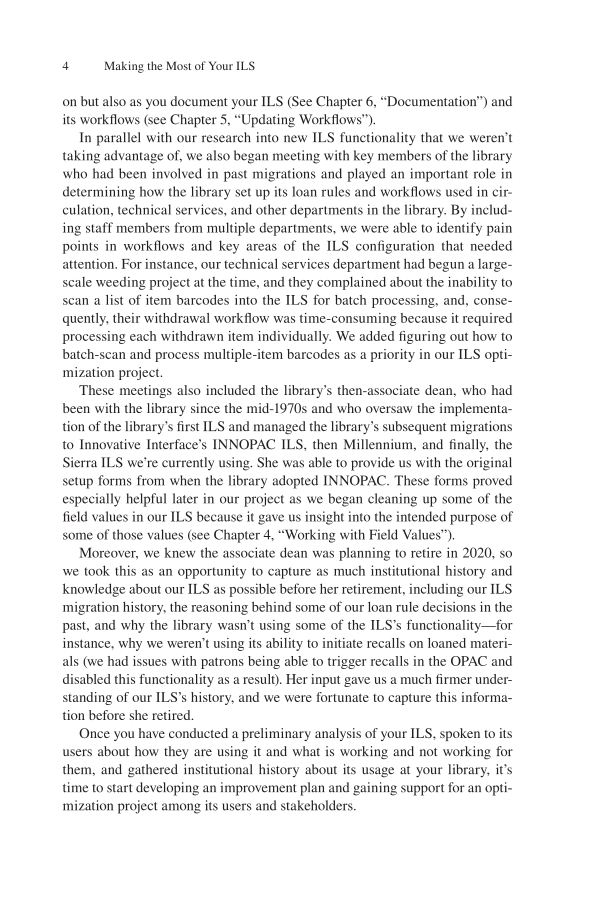4 Making the Most of Your ILS on but also as you document your ILS (See Chapter 6, “Documentation”) and its workflows (see Chapter 5, “Updating Workflows”). In parallel with our research into new ILS functionality that we weren’t taking advantage of, we also began meeting with key members of the library who had been involved in past migrations and played an important role in determining how the library set up its loan rules and workflows used in cir- culation, technical services, and other departments in the library. By includ- ing staff members from multiple departments, we were able to identify pain points in workflows and key areas of the ILS configuration that needed attention. For instance, our technical services department had begun a large- scale weeding project at the time, and they complained about the inability to scan a list of item barcodes into the ILS for batch processing, and, conse- quently, their withdrawal workflow was time-consuming because it required processing each withdrawn item individually. We added figuring out how to batch-scan and process multiple-item barcodes as a priority in our ILS opti- mization project. These meetings also included the library’s then-associate dean, who had been with the library since the mid-1970s and who oversaw the implementa- tion of the library’s first ILS and managed the library’s subsequent migrations to Innovative Interface’s INNOPAC ILS, then Millennium, and finally, the Sierra ILS we’re currently using. She was able to provide us with the original setup forms from when the library adopted INNOPAC. These forms proved especially helpful later in our project as we began cleaning up some of the field values in our ILS because it gave us insight into the intended purpose of some of those values (see Chapter 4, “Working with Field Values”). Moreover, we knew the associate dean was planning to retire in 2020, so we took this as an opportunity to capture as much institutional history and knowledge about our ILS as possible before her retirement, including our ILS migration history, the reasoning behind some of our loan rule decisions in the past, and why the library wasn’t using some of the ILS’s functionality—for instance, why we weren’t using its ability to initiate recalls on loaned materi- als (we had issues with patrons being able to trigger recalls in the OPAC and disabled this functionality as a result). Her input gave us a much firmer under- standing of our ILS’s history, and we were fortunate to capture this informa- tion before she retired. Once you have conducted a preliminary analysis of your ILS, spoken to its users about how they are using it and what is working and not working for them, and gathered institutional history about its usage at your library, it’s time to start developing an improvement plan and gaining support for an opti- mization project among its users and stakeholders.
Document Details My Account Print multiple pages
Print
You have printed 0 times in the last 24 hours.
Your print count will reset on at .
You may print 0 more time(s) before then.
You may print a maximum of 0 pages at a time.





































































































































































